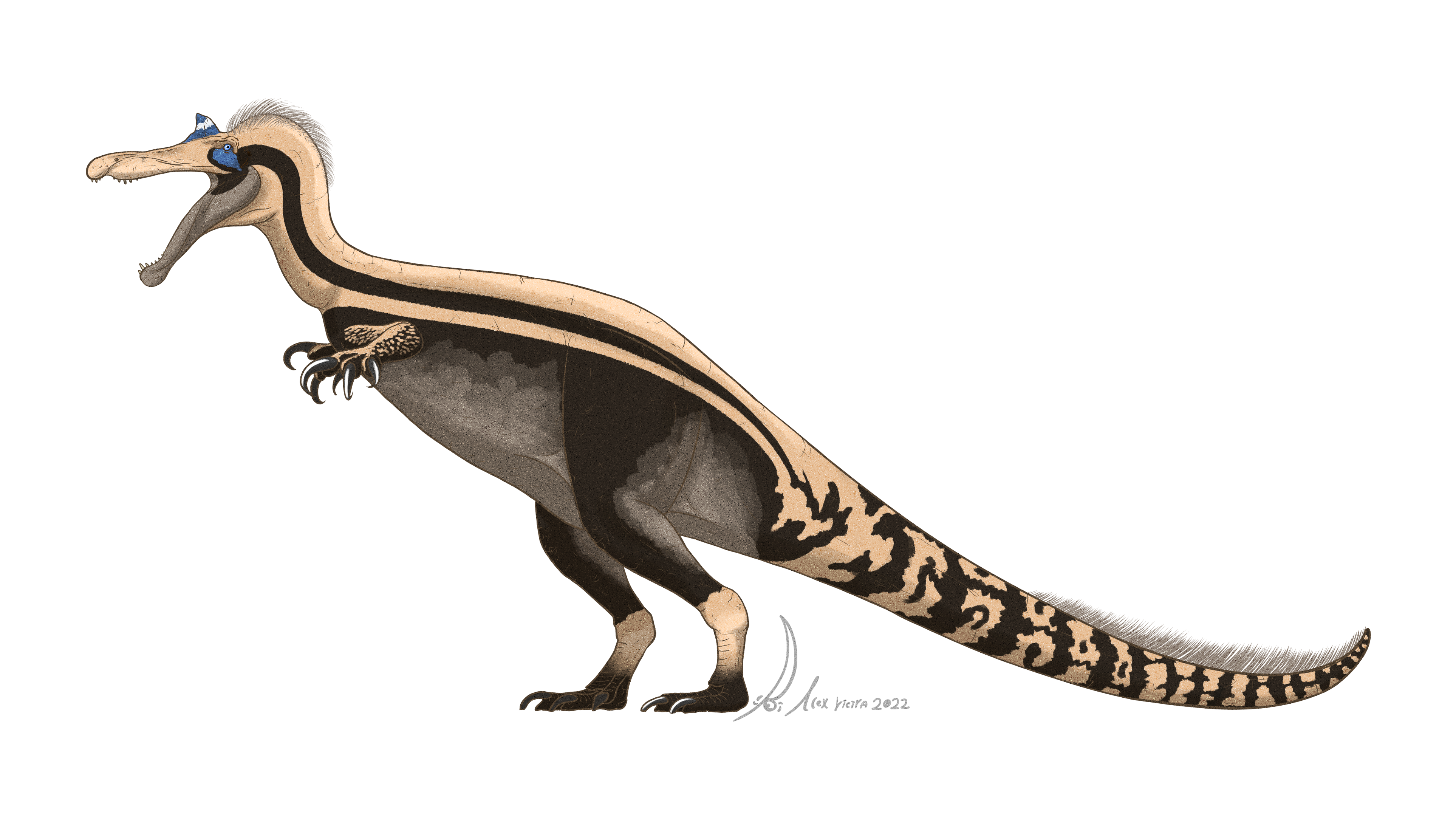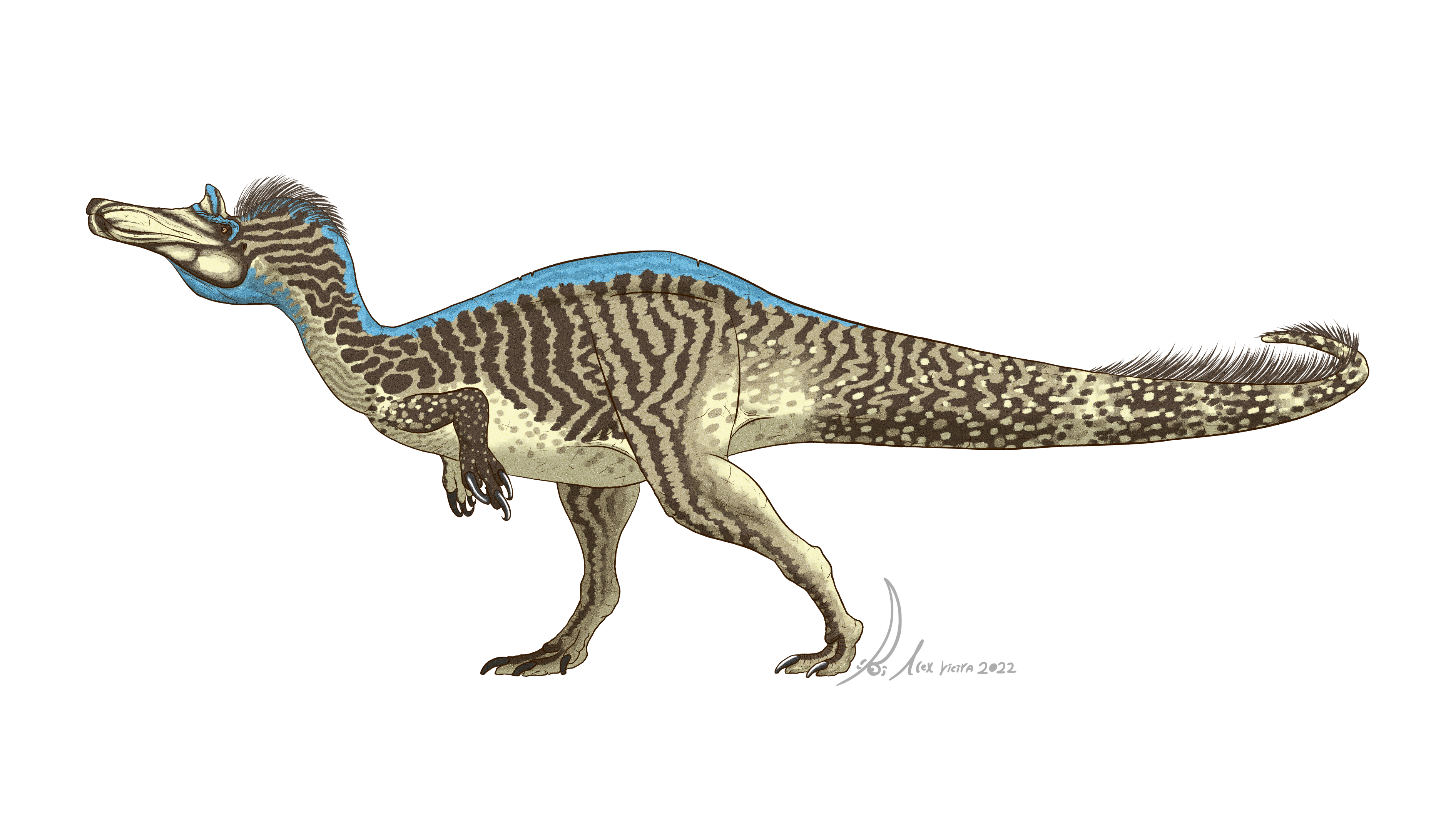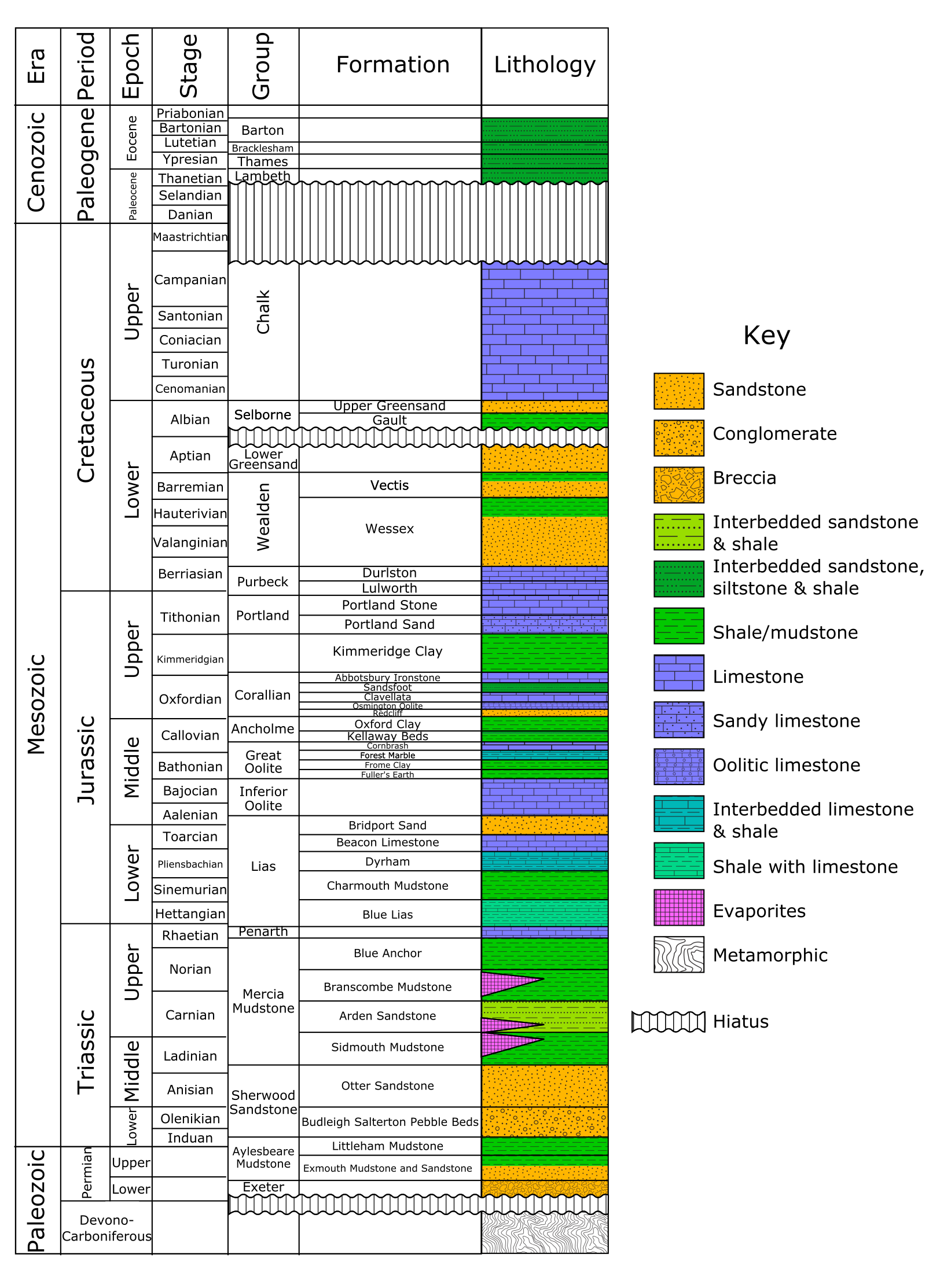|
Ceratosuchops
''Ceratosuchops'' (meaning "horned crocodile face") is a genus of spinosaurid from the Early Cretaceous (Barremian) of Britain. Discovery and naming In 2021, the type species ''C. inferodios'' was named and described by a team of paleontologists including Chris Barker, Darren Naish, David Hone and others. The specific name means "hell heron", in reference to the ecology presumed by the research team. The holotype remains of this taxon consist of IWCMS 2014.95.5 (premaxillary bodies), IWCMS 2021.30 (a posterior premaxilla fragment) and IWCMS 2014.95.1-3 (a nearly complete braincase), all of which were recovered from rocks in Chilton Chine of the Wessex Formation and stored at Dinosaur Isle museum. Referred remains include a single right postorbital (IWCMS 2014.95.4). Description ''Ceratosuchops'' is estimated to measure 8.5 m (27 ft) in length based on the skeletal reconstruction in the describing paper by Dan Folkes, 2021. Phylogeny The authors recovered ''Cerato ... [...More Info...] [...Related Items...] OR: [Wikipedia] [Google] [Baidu] |
Baryonychinae
Baryonychinae is an extinct clade or subfamily of spinosaurids from the Early Cretaceous (Valanginian-Albian) of Britain, Portugal, and Niger. In 2021, it consisted of six genera: ''Ceratosuchops'', ''Cristatusaurus'', ''Riparovenator'', ''Suchomimus'', '' Suchosaurus'', and ''Baryonyx'', the nominal genus. The clade was named by Charig & Milner in 1986 and defined by Sereno ''et al''. in 1998 and Holtz ''et al.'' in 2004 as all taxa more closely related to ''Baryonyx walkeri'' than to ''Spinosaurus aegyptiacus''. Baryonychines were large, bipedal predators with elongated, crocodile-like skulls and lower jaw tips fanning out into rosettes bearing conical, often unserrated, teeth, and a distinct premaxillary notch. They possessed robust forelimbs supporting three-fingered hands with an enlarged first digit claw, to which the subfamily name indirectly refers. Members of this group, unlike the more derived Spinosaurinae, sported only low sails or none at all. History of discovery ... [...More Info...] [...Related Items...] OR: [Wikipedia] [Google] [Baidu] |
Ceratosuchopsini
Baryonychinae is an extinct clade or subfamily of spinosaurids from the Early Cretaceous (Valanginian-Albian) of Britain, Portugal, and Niger. In 2021, it consisted of six genera: ''Ceratosuchops'', ''Cristatusaurus'', '' Riparovenator'', '' Suchomimus'', '' Suchosaurus'', and ''Baryonyx'', the nominal genus. The clade was named by Charig & Milner in 1986 and defined by Sereno ''et al''. in 1998 and Holtz ''et al.'' in 2004 as all taxa more closely related to '' Baryonyx walkeri'' than to ''Spinosaurus aegyptiacus''. Baryonychines were large, bipedal predators with elongated, crocodile-like skulls and lower jaw tips fanning out into rosettes bearing conical, often unserrated, teeth, and a distinct premaxillary notch. They possessed robust forelimbs supporting three-fingered hands with an enlarged first digit claw, to which the subfamily name indirectly refers. Members of this group, unlike the more derived Spinosaurinae, sported only low sails or none at all. History of di ... [...More Info...] [...Related Items...] OR: [Wikipedia] [Google] [Baidu] |
Ceratosuchops Inferodios By PaleoGeek
''Ceratosuchops'' (meaning "horned crocodile face") is a genus of spinosaurid from the Early Cretaceous (Barremian) of Britain. Discovery and naming In 2021, the type species ''C. inferodios'' was named and described by a team of paleontologists including Chris Barker, Darren Naish, David Hone and others. The specific name means "hell heron", in reference to the ecology presumed by the research team. The holotype remains of this taxon consist of IWCMS 2014.95.5 (premaxillary bodies), IWCMS 2021.30 (a posterior premaxilla fragment) and IWCMS 2014.95.1-3 (a nearly complete braincase), all of which were recovered from rocks in Chilton Chine of the Wessex Formation and stored at Dinosaur Isle museum. Referred remains include a single right postorbital (IWCMS 2014.95.4). Description ''Ceratosuchops'' is estimated to measure 8.5 m (27 ft) in length based on the skeletal reconstruction in the describing paper by Dan Folkes, 2021. Phylogeny The authors recovered ''Cerato ... [...More Info...] [...Related Items...] OR: [Wikipedia] [Google] [Baidu] |
Spinosaurid
The Spinosauridae (or spinosaurids) are a clade or family of tetanuran theropod dinosaurs comprising ten to seventeen known genera. They came into prominence during the Cretaceous period. Spinosaurid fossils have been recovered worldwide, including Africa, Europe, South America and Asia. Their remains have generally been attributed to the Early to Mid Cretaceous. Spinosaurids were large bipedal carnivores. Their crocodilian-like skulls were long, low and narrow, bearing conical teeth with reduced or absent serrations. The tips of their upper and lower jaws fanned out into a spoon-shaped structure similar to a rosette, behind which there was a notch in the upper jaw that the expanded tip of the lower jaw fit into. The nostrils of spinosaurids were retracted to a position further back on the head than in most other theropods, and they had bony crests on their heads along the midline of their skulls. Their robust shoulders wielded stocky forelimbs, with three-fingered hands that ... [...More Info...] [...Related Items...] OR: [Wikipedia] [Google] [Baidu] |
Spinosaurids
The Spinosauridae (or spinosaurids) are a clade or Family (taxonomy), family of tetanuran theropod dinosaurs comprising ten to seventeen known genera. They came into prominence during the Cretaceous Geological period, period. Spinosaurid fossils have been recovered worldwide, including Africa, Europe, South America and Asia. Their remains have generally been attributed to the Early Cretaceous, Early to Mid Cretaceous. Spinosaurids were large Bipedalism, bipedal carnivores. Their crocodilian-like skulls were long, low and narrow, bearing conical teeth with reduced or absent Glossary of dinosaur anatomy#serrations, serrations. The tips of their upper and Glossary of dinosaur anatomy#mandible, lower jaws fanned out into a spoon-shaped structure similar to a Rosette (design), rosette, behind which there was a Glossary of dinosaur anatomy#subnarial gap, notch in the upper jaw that the expanded tip of the lower jaw fit into. The Glossary of dinosaur anatomy#bony nostrils, nostrils of spi ... [...More Info...] [...Related Items...] OR: [Wikipedia] [Google] [Baidu] |
Baryonyx
''Baryonyx'' () is a genus of theropod dinosaur which lived in the Barremian stage of the Early Cretaceous period, about 130–125 million years ago. The first skeleton was discovered in 1983 in the Smokejack Clay Pit, of Surrey, England, in sediments of the Weald Clay Formation, and became the holotype specimen of ''Baryonyx walkeri'', named by palaeontologists Alan J. Charig and Angela C. Milner in 1986. The generic name, ''Baryonyx'', means "heavy claw" and alludes to the animal's very large claw on the first finger; the specific name, ''walkeri'', refers to its discoverer, amateur fossil collector William J. Walker. The holotype specimen is one of the most complete theropod skeletons from the UK (and remains the most complete Spinosaurid), and its discovery attracted media attention. Specimens later discovered in other parts of the United Kingdom and Iberia have also been assigned to the genus, though many have since been moved to new genera. The holotype specimen, whic ... [...More Info...] [...Related Items...] OR: [Wikipedia] [Google] [Baidu] |
Riparovenator
''Riparovenator'' ("riverbank hunter") is a genus of baryonychine spinosaurid dinosaur from the Early Cretaceous (Barremian) period of Britain, the type species is ''Riparovenator milnerae''. Discovery and naming Between 2013 and 2017, spinosaurid fossils were uncovered at the beach near the Chilton Chine before being brought to Dinosaur Isle. Such remains had been generally referred to ''Baryonyx'' but were understood recently to represent two species new to science. In 2021, the type species ''Riparovenator milnerae'' was named and described by a team of palaeontologists including Chris T. Barker, David William Elliot Hone, Darren Naish, Andrea Cau, Jeremy A.F. Lockwood, Brian Foster, Claire E. Clarkin, Philipp Schneider and Neil John Gostling. The generic name is derived from the Latin ''rīpārius'', "of the river bank", and ''vēnātor'', "hunter". The specific name honors Angela Milner, deceased in August 2021. The holotype remains of this taxon consist of IWCMS ... [...More Info...] [...Related Items...] OR: [Wikipedia] [Google] [Baidu] |
Wessex Formation
The Wessex Formation is a fossil-rich English geological formation that dates from the Berriasian to Barremian stages (about 145–125 million years ago) of the Early Cretaceous. It forms part of the Wealden Group and underlies the younger Vectis Formation and overlies the Durlston Formation. The dominant lithology of this unit is mudstone with some interbedded sandstones. It is part of the strata of the Wessex Basin, exposed in both the Isle of Purbeck and the Isle of Wight. While the Purbeck sections are largely barren of vertebrate remains, the Isle of Wight sections are well known for producing the richest and most diverse fauna in Early Cretaceous Europe. Nomenclatural History The Wessex Formation has historically alternately been called the "Variegated Marls And Sandstones", a name used by W. J. Arkell in his 1947 map of the Isle of Purbeck as well as the "Wealden Marls" It was given its current formal name by Daley and Stewart in 1979 Stratigraphy and Lithology In ... [...More Info...] [...Related Items...] OR: [Wikipedia] [Google] [Baidu] |
Suchomimus
''Suchomimus'' (meaning "crocodile mimic") is a genus of spinosaurid dinosaur that lived between 125 and 112 million years ago in what is now Niger, during the Aptian to early Albian stages of the Early Cretaceous period. It was named and described by palaeontologist Paul Sereno and colleagues in 1998, based on a partial skeleton from the Elrhaz Formation. ''Suchomimus'''s long and shallow skull, similar to that of a crocodile, earns it its generic name, while the specific name ''Suchomimus tenerensis'' alludes to the locality of its first remains, the Ténéré Desert. ''Suchomimus'' was a relatively large theropod, reaching in length and weighing . However, the age of the holotype specimen is uncertain, so it is unclear whether this size estimate would have been its maximum. The narrow skull of ''Suchomimus'' was perched on a short neck, and its forelimbs were powerfully built, bearing a giant claw on each thumb. Along the midline of the animal's back ran a low dorsal ... [...More Info...] [...Related Items...] OR: [Wikipedia] [Google] [Baidu] |
Fossils Of England
A fossil (from Classical Latin , ) is any preserved remains, impression, or trace of any once-living thing from a past geological age. Examples include bones, shells, exoskeletons, stone imprints of animals or microbes, objects preserved in amber, hair, petrified wood and DNA remnants. The totality of fossils is known as the ''fossil record''. Paleontology is the study of fossils: their age, method of formation, and evolutionary significance. Specimens are usually considered to be fossils if they are over 10,000 years old. The oldest fossils are around 3.48 billion years old to 4.1 billion years old. Early edition, published online before print. The observation in the 19th century that certain fossils were associated with certain rock strata led to the recognition of a geological timescale and the relative ages of different fossils. The development of radiometric dating techniques in the early 20th century allowed scientists to quantitatively measure the absolute ... [...More Info...] [...Related Items...] OR: [Wikipedia] [Google] [Baidu] |
Cretaceous England
The Cretaceous ( ) is a geological period that lasted from about 145 to 66 mya (unit), million years ago (Mya). It is the third and final period of the Mesozoic Era (geology), Era, as well as the longest. At around 79 million years, it is the longest geological period of the entire Phanerozoic. The name is derived from the Latin wikt:creta#Latin, ''creta'', "chalk", which is abundant in the latter half of the period. It is usually abbreviated K, for its German translation ''Kreide''. The Cretaceous was a period with a relatively warm climate, resulting in high Sea level#Local and eustatic, eustatic sea levels that created numerous shallow Inland sea (geology), inland seas. These oceans and seas were populated with now-extinct marine reptiles, ammonites, and rudists, while dinosaurs continued to dominate on land. The world was ice free, and forests extended to the poles. During this time, new groups of mammals and birds appeared. During the Early Cretaceous, flowering plants appeare ... [...More Info...] [...Related Items...] OR: [Wikipedia] [Google] [Baidu] |
Early Cretaceous Dinosaurs Of Europe
{{disambiguation, geo ...
Early may refer to: History * The beginning or oldest part of a defined historical period, as opposed to middle or late periods, e.g.: ** Early Christianity ** Early modern Europe Places in the United States * Early, Iowa * Early, Texas * Early Branch, a stream in Missouri * Early County, Georgia Other uses * ''Early'' (Scritti Politti album), 2005 * ''Early'' (A Certain Ratio album), 2002 * Early (name) * Early effect, an effect in transistor physics * Early Records, a record label * the early part of the morning See also * Earley (other) Earley is a town in England. Earley may also refer to: * Earley (surname), a list of people with the surname Earley * Earley (given name), a variant of the given name Earlene * Earley Lake, a lake in Minnesota *Earley parser, an algorithm *Earley ... [...More Info...] [...Related Items...] OR: [Wikipedia] [Google] [Baidu] |









